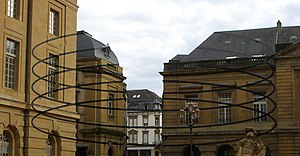Victoria & Albert Museum,
Ladies' Cloakroom,
Lower Floor
Lower Floor
The Swiss artist Felice Verini often paints on architectural and urban spaces, such as buildings,
walls and streets. He is known for his geometric perspective-localized paintings in indoor and outdoor locations, using projector-stencil techniques.
 Six Circles in Disorder is his first permanent installation in Britain.
Six Circles in Disorder is his first permanent installation in Britain.
 Six Circles in Disorder is his first permanent installation in Britain.
Six Circles in Disorder is his first permanent installation in Britain.
So what happens when you walk downstairs to the Cloakroom at the V&A?
You are confronted by a merry, lively pattern of arcs and curves on the walls and ceiling, which appear to move with the slightest change in your position. The broken fragments dance, hold hands, scatter again. They appear to react to your slightest movement.
I was reminded of an experience at Tate Britain in 2002. The artist Lucy Gunning constructed a room which looked from the outside like a simple wooden crate.(Installation View, Art Now, Tate Britain 2002). I walked in and found myself in a miniature ballet studio, walls covered with mirrors, and a polished wooden dance floor. I have never forgotten the experience of seeing dozens of life-size reflections of myself, each different, each responding to my every move. I was looking at this woman as a casual outsider
might. There was enough space to dance - and I might have done - but a group of lively young people burst in, all jolly and re-assuring. The spell was broken.
 Similarly Varini's painting responds to your every movement. But it is characterized by having one vantage point
from which the viewer can see the complete work, usually a simple
geometric shape such as circle, square or line.
Similarly Varini's painting responds to your every movement. But it is characterized by having one vantage point
from which the viewer can see the complete work, usually a simple
geometric shape such as circle, square or line. |
Thus if you move towards an exact spot in front of the mirror by the left sink, you can see the fragments miraculously come together in a deeply satisfying composition of six perfect circles.
Varini argues
that the work exists as a whole - with its complete shape as well as the
fragments. “My concern,” he says “is what happens outside the vantage
point of view.”[
According to mathematics professor and art critic Joel Koskas, "A work of Varini is anti-Mona Lisa". I wonder what that means? |


No comments:
Post a Comment